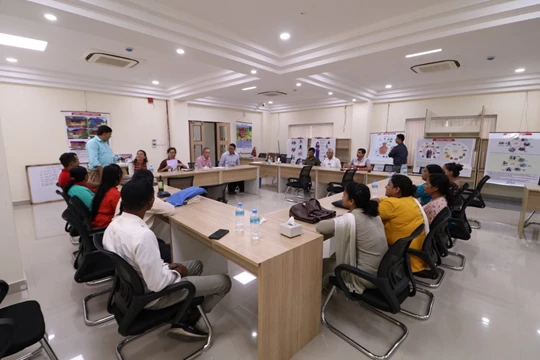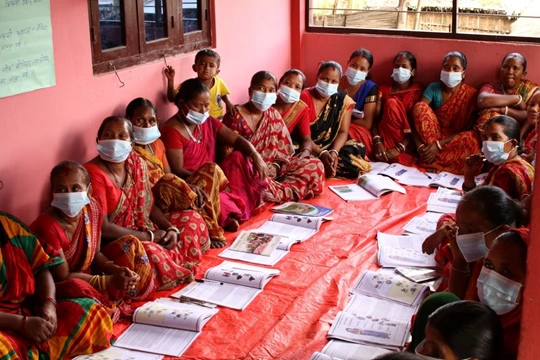Blog by Gilly Challinor - Senior Programme Officer, JOA
JOA monitoring generally happens mid-way through a grant — in this case it means we are two years into this project with our partners, Habitat for Humanity Great Britain, who are empowering people in the poorest communities through the provision of affordable and safe housing.
I’ve just returned from my first grant monitoring trip in Nepal. I’d heard only good things about Nepal but nothing could prepare me for just how colourful and beautiful the country is, and how warm and friendly the people are. The trip was pretty intense: non-stop information overload, combined with a bout of food poisoning and a few language and cultural challenges to overcome. Having said that, I loved every minute and it is a huge privilege to represent Jersey and have the chance to witness first hand the incredible impact that our small island is having in these remote corners of the world.
JOA monitoring generally happens mid-way through a grant — in this case it means we are two years into this project with our partners, Habitat for Humanity Great Britain, who are an international non-profit organisation (INGO) working to empower people in the poorest communities through the provision of affordable and safe housing.
This project falls under our ‘Financial Inclusion’ thematic area which might initially sound unusual given it’s about safe shelter, however this is a classic example of the enabling role of financial inclusion in development. Through providing women with access to and knowledge of financial products and services, they can improve their economic agency through savings and get access to affordable loans to improve their homes.
Having shelter is a basic human need, and our homes provide so much more than a roof over our heads. Our homes enable us to rest and cook meals, they provide safe havens for our families and give our children a place where they can thrive. Children can perform better in school because of their home security and having a well-lit environment where they can learn.
Most of the households we visited have a soil floor, bamboo wall and tin roof, making them susceptible to climate-related disasters. The majority of homes are built illegally on government land so there is a risk of eviction and inhabitants have no land rights or deeds. A quarter of the households in the target communities have an income less than NPR10,000 (around £70 per month).
The status of housing directly affects health, security, empowerment and wellbeing. So, investment in housing is a priority for most people. But marginalised low income people have to give higher priority to providing food for their families and basic medical services before housing.
This four year project starting from 1st August 2020 has the goal to improve financial security and safer housing for low income women through increased economic empowerment and the availability of affordable financial services including housing loans.
A few observations
Having this opportunity to fully immerse myself into one of our 33 ongoing development projects has provided a much deeper understanding of the challenges and opportunities for financial inclusion in Nepal. Here are a few observations from the week that I thought I’d share:
1. In rural Nepal, cash is preferred
Despite major advances in the adoption of digital and technology as a result of COVID-19, people still prefer to deal in cash. Adoption of digital financial services (DFS) is slow in poor, rural communities. It’s not because there’s no network coverage — there is. And not so much to do with smartphone adoption — although this is a challenge for some and there is still a huge digital skills gap in rural Nepal. The main reason is that physical cash is more trusted, thought to be cheaper (for tax reasons) and is more widely accepted. Mobile apps do exist for payment transfers, although not all financial service providers have developed apps. And even where there are apps available, low literacy and low digital literacy mean that people don’t know how to use them.
2. Housing loans are a profitable money-making opportunity for micro finance institutions (MFIs)
The central bank in Nepal does not recognise housing loans as a ‘productive’ business model — unlike something like loans for micro-entrepreneurs for example which are thought to be more profitable. This deters some lenders from offering housing loan products to low-income households. However, from the housing loan products that have been developed and piloted as a result of this project, evidence suggests otherwise. The housing loans have the lowest default rates meaning they are being repaid on time and are being used for their intended purpose — to provide self shelter.
3. Financial literacy training empowers women in multiple ways
From the focus group discussions, I heard time and again about improved savings habits among women, and how they have learnt to prioritise their ‘needs’ over their ‘wants’ in order to reduce their spending. When I asked what type of questions they might ask a visiting loan officer, they talked about interest rates and loan tenure. Two of the women I spoke to had started their own micro-enterprises which they attributed to the training having given them the confidence to get started.
4. Men hold the power for financial decision making
This project focuses on women’s empowerment, however social and gender norms mean that men still hold the decision-making power within the households since they are generally the breadwinners. Men tend to be more likely to spend money on their own ‘wants’ as opposed to their ‘needs’ (alcohol was an example of an unnecessary ‘want’). For this reason, one of the areas that is under consideration for the remaining years of the project is to start including men in the financial literacy training to ensure buy in from the wider household members.
5. Having safe housing is more than just a human need
The results of the housing loan pilots run by two of the microfinance institutions (MFIs) showed that when people received loans to improve their housing, they felt improved dignity and respect in their society. Through better lighting and space for reading, there is an improvement in educational outcomes for children. Health costs decrease due to better sanitation. Some households can earn income from rent from their homes. And some respondents from the pilot stated that they were able to start a business venture such as tailoring or poultry in their homes. Housing loans lead to a reduction in spending on house repairs and maintenance; meaning more opportunities to save money in the long term.
6. Bridging the digital divide requires innovative human-centred approaches
One of the MFIs that’s involved in this project is particularly advanced in terms of digitalisation of their products and services. But the women I spoke to were nervous about DFS (digital financial services) and even those with smartphones hadn’t actually used the app that was available. The transition to DFS is inevitable and for the next generation I believe it may be the only option as governments strive towards a cashless digital economy. One of the ways that this particular MFI has been trialling their app is by using a human ATM (“Authorised Teller Member”). I met a shopkeeper who had been trained to be a human ATM by the MFI — she uses the mobile app so that she can carry out transactions like loan repayments and mobile phone bill payments on behalf of members of her community. They come to her shop, give her the cash, and she makes the transactions for them. This saves each person NPR 2,000 in travel costs (they no longer have to travel to their nearest bank branch) as well as giving them 2 hours back in their day from saved travel time.
7. A systems-thinking approach is needed to mitigate against the effects of inflation
Inflation is increasing the cost of housing and materials; this is obvious. The less obvious one for me was how the regulatory and policy environment in Nepal is hindering the financial sector’s ability to provide affordable financial products and services to the poorest communities. For example, the maximum interest rate that an MFI is permitted to ask for on housing loans is 15%, but MFIs receive wholesale loans from commercial banks with an interest rate of 16% or more due to inflation. This means that MFIs cannot offer housing loans to people without incurring losses in the long term. Habitat for Humanity take a systems thinking approach to their work, meaning they advocate for change at the government regulation level in order to achieve sustainable impact for their target beneficiaries.
About JOA monitoring
JOA monitoring is led by our Monitoring and Impact Officer, Rebecca Curtis, who carefully plans lines of enquiry that are directly tied to the intended outcomes and indicators of the project. During a week-long monitoring visit, we delve into whether a project is on course to achieving its intended impact as well as assessing the likelihood of sustainability. And equally as important, it offers us a learning opportunity to discover how we as a donor can provide the most meaningful support to our partners going forward.
During this visit with Habitat for Humanity in Nepal, we spent a day with the implementing teams in their offices, reviewing policies and checking procedures, including safeguarding, procurement and financial management. We then spent three days in the field meeting the wider team and delivery partners as well as holding focus group discussions with different beneficiary groups.
About the project
Habitat for Humanity Nepal and Sahara Nepal are implementing the ‘Financial Inclusion for Marginalized Women in Nepal’ project among low-income people in Jhapa, Morang, Udayapur, and Saptari districts with support from Jersey Overseas Aid (JOA) through Habitat for Humanity Great Britain. The project seeks to expand and ensure continued access to microfinance (supply-side) and build awareness and financial literacy capabilities of marginalised communities in four districts of Nepal to finance and build safer homes using microfinance loans (demand-side). Capitalizing on ongoing efforts, this project will contribute to an uptake of 112,000 housing loans by marginalised, low-income women by 2024.
The project aims to achieve two key outcomes over the course of the 4 years:
1. Low-income families have increased capacity and awareness on how to access microfinance loans for financing and planning their home improvements.
2. MFIs have increased capacity to offer client-centric housing loans that meet the needs of clients from marginalised, low-income communities.
(All photographs credited to Habitat for Humanity)






